Output, the core concept of webpack
After gathering all the assets together, you also need to tell webpack where to package the application. The output attribute of webpack describes how to handle bundled code. The following article will give you an in-depth understanding of the output (Output) in the core concept of webpack. I hope it will be helpful to you!
Output: Configuring the output option can control how webpack writes compiled files to the hard disk. Note that even though multiple entry points can exist, only one output configuration is specified.
Start
We first npm init initialize a project and install webpack and webpack locally -cli, then create index.html, webpack.config.js and src folders in the root directory, and create another one inside the folder main.jsAs the entry file
After the preparation work is completed, as shown in the figure:
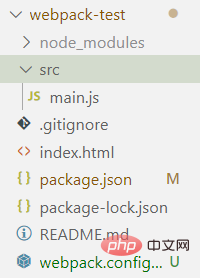
main. js
function Component(){
var div=document.createElement('div')
div.innerHTML="来一起学习出口配置吧~"
return div
}
document.body.appendChild(Component())index.html
<script></script>
packag.json
"scripts": {
"test": "echo \"Error: no test specified\" && exit 1",
"build":"webpack" //加上
},The next step is the configuration part:webpack.config.js
Output)
Configurationoutput options can control how webpack sends The compiled file is written to the hard disk.
Note that even though there can be multiple entrancesstarting points, only one outputconfiguration
The following are several output configurations Concept:
1, path
path specifies the location of resource output, and the required value must be an absolute path , such as :
const path=require('path')
module.exports={
entry:'./src/main.js',
output:{
filename:'bundle.js',
//将资源输出位置设置为该项目的dist目录
path: path.resolve(__dirname, 'dist')
},
}After Webpack 4, output.path has defaulted to the dist directory. Unless we need to change it, there is no need to configure it separately, so if it is webpack4 or above, you can write:
module.exports={
entry:'./src/main.js',
output:{
filename:'bundle.js',
},
}2, filename
filename The function is to control the file name of the output resource, which is in the form of a string. Here I named it bundle.js, which means I want the resources to be output in a file called bundle.js:
module.exports={
entry:'./src/main.js',
output:{
filename:'bundle.js',
},
}As shown in the figure after packaging, a # will be automatically generated. ##dist folder, there is a bundle.js file
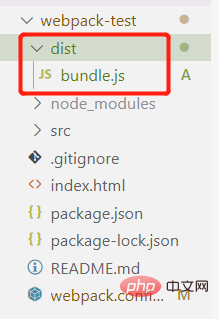
filename can be not only the name of the bundle, but also It can be a relative path
It doesn’t matter even if the directory in the path does not exist, Webpack will create the directory when outputting resources, for example: module.exports = {
output: {
filename: './js/bundle.js',
},
};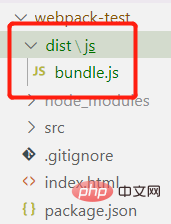
In a multi-entry scenario, we need to specify a different name for each generated bundle. Webpack supports the use of a similar template language Dynamically generate the file name in the form
Before that, we create a new entry filevender.js in src
function Component(){
var div=document.createElement('div')
div.innerHTML="我是第二个入口文件"
return div
}
document.body.appendChild(Component())module.exports = {
entry:{
main:'./src/main.js',
vender:'./src/vender.js'
},
output: {
filename: '[name].js',
},
};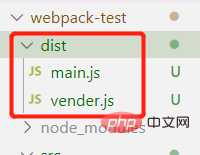
[name] in filename will Replaced with chunk name, namely main and vendor. Therefore, vendor.js and main.js
index.htmlChange the content in the middle and match the path to the last packaged bundle
<script></script> <script></script>
[Question] There will be a need at this time, how to makeindex.html
automatically help What if we add the generated bundle to html? The plug-in HtmlWebpackPlugin can be used here. See the details below
3. Others
except[name] In addition to chunk name, there are several other template variables that can be used in the configuration of filename:
- [hash]: refers to the hash generated by Webpack for packaging all resources this time
- [chunkhash]: refers to the hash of the current chunk content
- [id]: refers to the id of the current chunk
- [query]: refers to the query
- in the filename configuration item
Control client-side caching
[hash] and [chunkhash] are both directly related to chunk content , if used in filename, when the content of the chunk changes, it can also cause the resource file name to change, so that the user will immediately download the new version when requesting the resource file next time without using the local cache.
[query] can also have a similar effect, but it has nothing to do with the chunk content and must be manually specified by the developer.
4、publicPath
publicPath是一个非常重要的配置项,用来指定资源的请求位置
以加载图片为例
import Img from './img.jpg';
function component() {
//...
var img = new Image();
myyebo.src = Img //请求url
//...
} {
//...
query: {
name: '[name].[ext]',
outputPath: 'static/img/',
publicPath: './dist/static/img/'
}
}由上面的例子所示,原本图片请求的地址是./img.jpg,而在配置上加上publicPath后,实际路径就变成了了./dist/static/img/img.jpg,这样就能从打包后的资源中获取图片了
publicPath有3种形式:
-
HTML相关
我们可以将publicPath指定为HTML的相对路径,在请求这些资源时会以当前页面HTML所在路径加上相对路径,构成实际请求的URL
//假设当前html地址为:https://www.example.com/app/index.html //异步加载的资源名为 1.chunk.js pubilicPath:"" //-->https://www.example.com/app/1.chunk.js pubilicPath:"./js" //-->https://www.example.com/app/js/1.chunk.js pubilicPath:"../assets/" //-->https://www.example.com/assets/1.chunk.js
Copy after login -
Host相关
若publicPath的值以“/”开始,则代表此时publicPath是以当前页面的host name为基础路径的
//假设当前html地址为:https://www.example.com/app/index.html //异步加载的资源名为 1.chunk.js pubilicPath:"/" //-->https://www.example.com/1.chunk.js pubilicPath:"/js/" //-->https://www.example.com/js/1.chunk.js
Copy after login -
CDN相关
上面两个都是相对路径,我们也可以使用绝对路径的形式配置publicPath
这种情况一般发生于静态资源放在CDN上面时,由于其域名与当前页面域名不一致,需要以绝对路径的形式进行指定
当publicPath以协议头或相对协议的形式开始时,代表当前路径是CDN相关
//假设当前html地址为:https://www.example.com/app/index.html //异步加载的资源名为 1.chunk.js pubilicPath:"http://cdn.com/" //-->http://cdn.com/1.chunk.js pubilicPath:"https://cdn.com/" //-->https://cdn.com/1.chunk.js pubilicPath:"//cdn.com/assets" //-->//cdn.com/assets/1.chunk.js
Copy after login
应用
1、单个入口
在 webpack 中配置 output 属性的最低要求是将它的值设置为一个对象,包括以下两点:
-
filename用于输出文件的文件名。 - 目标输出目录
path的绝对路径
module.exports={
entry:'./src/main.js',
output:{
filename:'bundle.js',
},
}
//webpack4以后dist会默认生成,于是这里省略了path2、多个入口
如果配置创建了多个单独的 "chunk",则应该使用占位符来确保每个文件具有唯一的名称
这里用到了上面所讲的filename的[name]
另外,如果想将这些资源放进指定的文件夹,可以加上path配置
module.exports={
entry: {
main: './src/main.js',
vender: './src/vender.js'
},
output: {
filename: '[name].js',
path: __dirname + '/dist/assets' //指定打包后的bundle放在/dist/assets目录下
}
}
// 打包后生成:./dist/assets/main.js, ./dist/assets/vender.jsHtmlWebpackPlugin
本章上方遗留的问题可以通过使用插件HtmlWebpackPlugin解决
安装插件
npm install --save-dev html-webpack-plugin
配置插件
const HtmlWebpackPlugin=require('html-webpack-plugin') //加载模块
module.exports = {
entry:{
main:'./src/main.js',
vender:'./src/vender.js'
},
//添加插件
plugins:[
new HtmlWebpackPlugin({
title:'output management'
})
],
output: {
filename: '[name].js',
},
};打包
打包完成后你会发现dist中出现了一个新的index.html,上面自动帮我们添加所生成的资源,打开后会发现浏览器会展示出内容

这意味着,以后初始化一个项目就不必写index.html了
源码可从这里获取:
https://sanhuamao1.coding.net/public/webpack-test/webpack-test/git/files
更多编程相关知识,请访问:编程视频!!
The above is the detailed content of Output, the core concept of webpack. For more information, please follow other related articles on the PHP Chinese website!

Hot AI Tools

Undresser.AI Undress
AI-powered app for creating realistic nude photos

AI Clothes Remover
Online AI tool for removing clothes from photos.

Undress AI Tool
Undress images for free

Clothoff.io
AI clothes remover

Video Face Swap
Swap faces in any video effortlessly with our completely free AI face swap tool!

Hot Article

Hot Tools

Notepad++7.3.1
Easy-to-use and free code editor

SublimeText3 Chinese version
Chinese version, very easy to use

Zend Studio 13.0.1
Powerful PHP integrated development environment

Dreamweaver CS6
Visual web development tools

SublimeText3 Mac version
God-level code editing software (SublimeText3)

Hot Topics
 1390
1390
 52
52
 VUE3 Getting Started Tutorial: Packaging and Building with Webpack
Jun 15, 2023 pm 06:17 PM
VUE3 Getting Started Tutorial: Packaging and Building with Webpack
Jun 15, 2023 pm 06:17 PM
Vue is an excellent JavaScript framework that can help us quickly build interactive and efficient web applications. Vue3 is the latest version of Vue, which introduces many new features and functionality. Webpack is currently one of the most popular JavaScript module packagers and build tools, which can help us manage various resources in our projects. This article will introduce how to use Webpack to package and build Vue3 applications. 1. Install Webpack
 What is the difference between vite and webpack
Jan 11, 2023 pm 02:55 PM
What is the difference between vite and webpack
Jan 11, 2023 pm 02:55 PM
Differences: 1. The startup speed of the webpack server is slower than that of Vite; because Vite does not require packaging when starting, there is no need to analyze module dependencies and compile, so the startup speed is very fast. 2. Vite hot update is faster than webpack; in terms of HRM of Vite, when the content of a certain module changes, just let the browser re-request the module. 3. Vite uses esbuild to pre-build dependencies, while webpack is based on node. 4. The ecology of Vite is not as good as webpack, and the loaders and plug-ins are not rich enough.
 How to use PHP and webpack for modular development
May 11, 2023 pm 03:52 PM
How to use PHP and webpack for modular development
May 11, 2023 pm 03:52 PM
With the continuous development of web development technology, front-end and back-end separation and modular development have become a widespread trend. PHP is a commonly used back-end language. When doing modular development, we need to use some tools to manage and package modules. Webpack is a very easy-to-use modular packaging tool. This article will introduce how to use PHP and webpack for modular development. 1. What is modular development? Modular development refers to decomposing a program into different independent modules. Each module has its own function.
 How does webpack convert es6 to es5 module?
Oct 18, 2022 pm 03:48 PM
How does webpack convert es6 to es5 module?
Oct 18, 2022 pm 03:48 PM
Configuration method: 1. Use the import method to put the ES6 code into the packaged js code file; 2. Use the npm tool to install the babel-loader tool, the syntax is "npm install -D babel-loader @babel/core @babel/preset- env"; 3. Create the configuration file ".babelrc" of the babel tool and set the transcoding rules; 4. Configure the packaging rules in the webpack.config.js file.
 Use Spring Boot and Webpack to build front-end projects and plug-in systems
Jun 22, 2023 am 09:13 AM
Use Spring Boot and Webpack to build front-end projects and plug-in systems
Jun 22, 2023 am 09:13 AM
As the complexity of modern web applications continues to increase, building excellent front-end engineering and plug-in systems has become increasingly important. With the popularity of Spring Boot and Webpack, they have become a perfect combination for building front-end projects and plug-in systems. SpringBoot is a Java framework that creates Java applications with minimal configuration requirements. It provides many useful features, such as automatic configuration, so that developers can build and deploy web applications faster and easier. W
 What files can vue webpack package?
Dec 20, 2022 pm 07:44 PM
What files can vue webpack package?
Dec 20, 2022 pm 07:44 PM
In vue, webpack can package js, css, pictures, json and other files into appropriate formats for browser use; in webpack, js, css, pictures, json and other file types can be used as modules. Various module resources in webpack can be packaged and merged into one or more packages, and during the packaging process, the resources can be processed, such as compressing images, converting scss to css, converting ES6 syntax to ES5, etc., which can be recognized by HTML. file type.
 What is Webpack? Detailed explanation of how it works?
Oct 13, 2022 pm 07:36 PM
What is Webpack? Detailed explanation of how it works?
Oct 13, 2022 pm 07:36 PM
Webpack is a module packaging tool. It creates modules for different dependencies and packages them all into manageable output files. This is especially useful for single-page applications (the de facto standard for web applications today).
 Front-end output settings
Feb 19, 2024 am 09:30 AM
Front-end output settings
Feb 19, 2024 am 09:30 AM
Front-end output configuration requires specific code examples. In front-end development, output configuration is a very important configuration. It is used to define the file path, file name and related resource paths generated after the project is packaged. This article will introduce the role of front-end output configuration, common configuration options, and give specific code examples. The role of output configuration: The output configuration item is used to specify the file path and file name generated after the project is packaged. It determines the final output of the project. Packaged in webpack etc.




